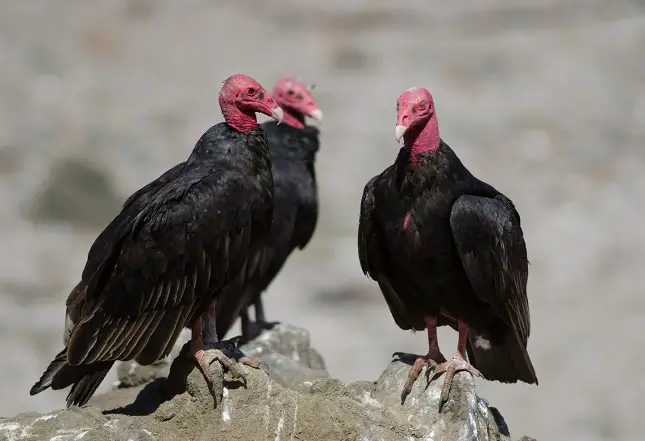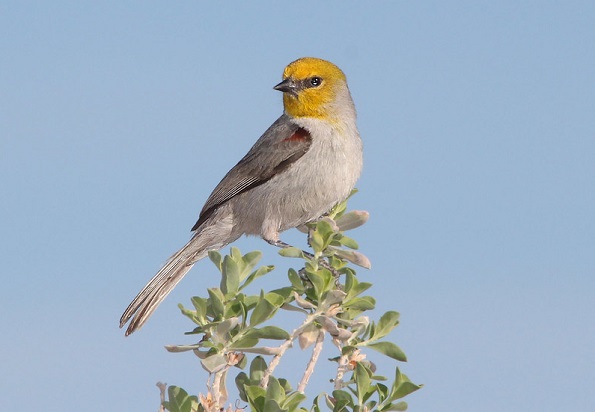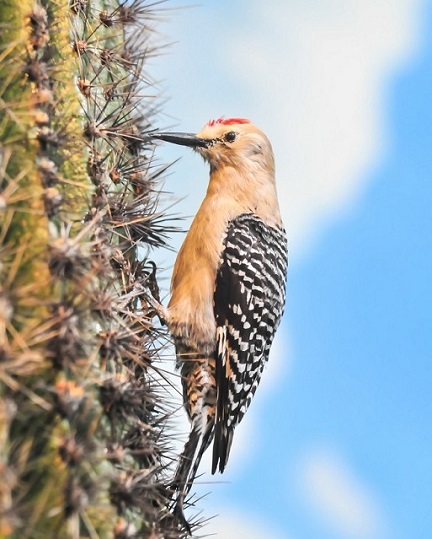A desert is a barren land that has little or no water. Due to this, it is hard to find many plants and animals in it.
However, few plants, animals, and birds survive in such harsh conditions due to their adaptation. The Birds that stay in the desert include
- Cactus Wren ( Campylorhynchusbrunneicapillus)
- Lucifer Hummingbird (Calothorax lucifer)
- Greater Roadrunner (Geococcyx californianus)
- Turkey Vulture (Cathartesaura )
- Verdin (Auriparusflaviceps)
- Indigo Bunting (Passerinacyanea)
- Gila Woodpecker (Melanerpes uropygialis)
- Hwamei (Garrulaxcarnorus)
- Ferruginous Pygmy-Owl (Glaucidium brasilianum)
- Rosy-Faced Lovebird( Agapornisroseicollis)
- Pin-tailed Sandgrouse (Pteroclesalchata)
Physiological Adaptations in Desert Birds
The rate at which desert birds metabolize energy is lower than the other species of birds.
This lower rate of metabolism translates into low energy expenditure, which allows desert birds to utilize it when food is scarce.
They execute hyperthermia by elevating their body temperature to 2 to 4 degrees above average.
This leads to lower evaporative loss from the body of the desert bird. This all makes their survival in the deserts easy.
In such extreme and scanty conditions, desert birds show remarkable adaptability skills that help them thrive in the desert.
Some birds and their desert adaptations are mentioned below:
Birds of Desert and their Adaptations
Cactus Wren (Campylorhynchusbrunneicapillus)
The cactus wren is considered the most significant wren type in the US. The size of this bird is close to the Spotted Towhee.
The Cactus Wren has the following characteristics:
- Long and rounded tail
- Long heavy bills
- Brown in color
- Have white eyebrows
- Short rounded wings
Geographical Distribution
Generally, the Cactus Wren is distributed throughout the deserts of the southwestern world.
Feeding Habits
The bird feeds on insects such as beetles, grasshoppers, wasps, ants, etc. Sometimes, the bird feeds on fruits, small frogs, and reptiles.
Desert Adaptations
Cactus Wrens are commonly seen perching on the top of shrubs and cacti plants. It is said that the birds perch on the cacti to announce their presence.
As they do not feed on any plant product, they can thrive in the desert with the slightest hindrance.
Lucifer Hummingbird (Calothorax lucifer)

Lucifer Hummingbirds are a species of sexually dimorphic birds.
The male birds are characterized by having iridescent plumage and a purple-colored gorget.
The gorget flares on the sides.
Females are characterized by iridescent green plumage with a cinnamon patch on the upper part of the feathers.
Geographical Distribution
Lucifer Hummingbirds are generally found in the deserts of northern and central regions of Mexico. Some parts of West Texas also witness these birds in their deserts.
Feeding Habits
The birds feed on the nectar of plants, such as anisacanth, penstemon, and agave. In some instances, they also feed on insects.
Desert Adaptations
Hummingbirds are specially adapted to thrive in deserts.
Because they feed on forage found in the biome, the birds can easily survive in the harsh conditions of the desert.
Apart from this, the Lucifer Hummingbirds have the feature of developing a unique call in the form of shrill shrieks to announce their presence in the desert and conserve their energy.
Greater Roadrunner (Geococcyx californianus)

Greater Roadrunner is found in the desert and has the following characteristics:
- Have a straight tail
- Have a long neck
- Slightly curved bill
- The Head has a short crest
Geographical Distribution
The bird is found in dry, open countries like North America. The bird is restricted to only the desert area.
Feeding habit
The roadrunner species eat insects, other birds, small reptiles, mice, and fruits. They also feed on the matter that falls on the ground.
Desert Adaptations
The Greater Roadrunner runs very rapidly on the road of the deserts. When they encounter their prey, they run swiftly to follow them.
They also cock their tail up when they hunt. The rapid running makes them thrive in the hostile conditions of the desert.
The toe is modified to run fast on the grounds of the desert.
Turkey Vulture (Cathartesaura)

These birds are designed to live on carrion (decaying flesh of animals). They can also wait for their meals for a few days to conserve their energy.
Turkey Vulture has a good sense of eyesight, which helps cite the feed in the desert.
They have wrinkled heads and lack feathers.
Geographical Distribution
These birds are found in warmer parts of Europe and America. Some parts of Africa and Asia also witness these birds.
Feeding habits
They are insectivorous. They feed on small insects, dead animals, etc
Desert Adaptations
They are keen hunters and can see their feed from a very long distance. They have insulated bodies to prevent themselves from the heat of the desert.
Verdin (Auriparusflaviceps)

Verdins are seen in the desert as Gray birds. The young Verdins are characterized by having.
- Gray plumage
- short bills
- thick bases
- pointed tips
As the Verdins grow, they start glowing yellow-colored feathers on their heads and chestnut-colored feathers on their shoulders. This marks their growing-up phase.
Geographical Distribution
Verdins are commonly found in thorny shrub areas of the southwestern United States and northern Mexico.
Feeding Habits
Verdin birds commonly feed on insects like beetles, larvae, caterpillars, and tiny spiders. They, at times, also feed on fruits like berries and tiny seeds.
Desert Adaptations
Verdins stay in the shaded part of the desert to protect themselves from its scorching heat.
They set up their nests in the opposite direction of the wind to get cooler temperatures. All this adds up to their coping mechanism.
Indigo Bunting (Passerinacyanea)
As the name suggests, the birds have beautiful blue plumage with dark-colored legs. They have short beaks, and the males have blue plumage or darker blue plumage in breeding seasons.
The females and juvenile Indigo birds have brown-colored plumage with a tinge of blue on their tails.
Geographical distribution
The eastern parts of North America and the southern parts of Coniferous forest regions are the habitats of Indigo Bunting birds.
Feeding habits
These birds don’t drink water specifically but fulfill their water needs from the matters they take up.
They eat up insects like beetles, tiny spiders, caterpillars, herbs, berries, and seeds of grasses.
Desert Adaptations
These birds are categorized into migratory birds. They can fly up to 3500 km in flocks at night.
Their feeding habits also align with the desert conditions, making them adjustable to the conditions.
In the breeding seasons, they leave the desert land.
Gila Woodpecker (Melanerpes uropygialis)
These birds show sexual dimorphism. Males have a white and black colored body. They have tan heads and bellies with a red crown patch.
Females possess the same plumage as males do. But females lack crown patches.
Geographical distribution
Gila Woodpeckers are distributed in southeast California, southwest Nevada, Southern Arizona, and some parts of Mexico.
Feeding habits
These birds mainly feed on insects. But sometimes, they feed on cactus fruits, some small berries, etc.
These desert birds are good at licking up sugary water from the plants.
Desert Adaptations
This species of woodpecker is famous for its flexible head and neck muscles. The long and pointed beak also helps peck into hard materials in the desert.
Further, their diet does not contain water, making them thrive in the desert longer.
Hwamei (Garrulaxcarnorus)
These medium-sized desert birds have olive-brown plumage, grey bellies, and some faint bars on the tails.
Their eyes are also encircled by some eye rings and lines from behind.
Geographical Distribution
Hwamei birds are endemic in the western and southern parts of China and some regions of Laos.
Feeding habits
These desert birds are also insectivorous. They feed on insects like locusts, beetles, caterpillars, and seeds of crops.
During the breeding seasons, they feed on seeds and crops.
Desert Adaptations
They are sometimes referred to as the “melodious laughing thrush.” They sing a melodious song that is distinct from their species.
They primarily feed on insects, which helps them survive in the desert. Hwamei birds are difficult to find in the wild.
Ferruginous Pygmy-Owl (Glaucidium brasilianum)
These bird species are the most numerous in the Glaucidium genus. These birds show the following characteristics.
- They have distinct black marks on their napes (back of the head & neck area)
- The distinct colored tails
- Large rounded heads
- Have dull grayish plumage with underparts.
Ferruginous birds face a lot of dangers in their habitat. They are considered endangered in Arizona.
Geographical Distribution
These birds have a variety of habitats in the lowlands. Some parts of the US and Argentina have also witnessed these birds in the desert.
Feeding habits
These types of owls are active near dawn and dusk. They feed largely on insects like crickets, beetles, caterpillars, small rodents, lizards, and scorpions.
Desert Adaptations
Ferruginous Pygmy Owls are not migratory birds. They remain in the desert throughout their life span.
These birds nest up nests in tree cavities or cacti holes.
These holes are made up of woodpeckers, and these owls use it.
The insectivorous nature of these owls makes them thrive in the harsh conditions of the desert.
Rosy-Faced Lovebird(Agapornisroseicollis)
At primary times, these birds were called Peached-faced Lovebirds. They are identifiable due to their rose to peach-colored faces.
This lovebird has green plumage with tinges of blue on its back. They look lovely in appearance.
Geographical Distribution
In some parts of southwestern Africa, these birds are endemic. The parts like Namibia and Northern Cape Province.
Feeding Habit
Their diet comprises small fruits, small seeds, seed pods, and cactus fruits.
Desert Adaptations
The lovebird is fully adapted to live in deserts. These birds are dependent on the water sources in the desert.
When water is unavailable or little in the desert, these birds may also show some nomadic tendencies.
These adaptations of lovebirds make a living good in the desert.
Pin-tailed Sandgrouse (Pteroclesalchata)
Sandgrouse birds also show sexual dimorphism.
The male bird has colorful plumage that consists of a yellowish face, upper chest, neck, and golden spots on the shoulders and back.
The female birds are less colorful than the male ones. They have a whitish chin and greyish wings with black patches.
Geographical Distribution
These desert birds are commonly found in semi-arid parts of northwestern Africa, the Middle East, North America, south-eastern Turkey, and some regions of Europe.
Feeding Habits
These birds feed on small seeds and small plants found in the desert. Sandgrouse can also feed on leaves, short shoots, and flowers.
Desert Adaptations
As they live in semi-arid regions of the desert, they show a good sense of adaptability there. Because of their dense plumage, they don’t feel hot in the harsh weather of the desert.
Further, the feathers also give insolation to the bird against the hot conditions of the desert.




